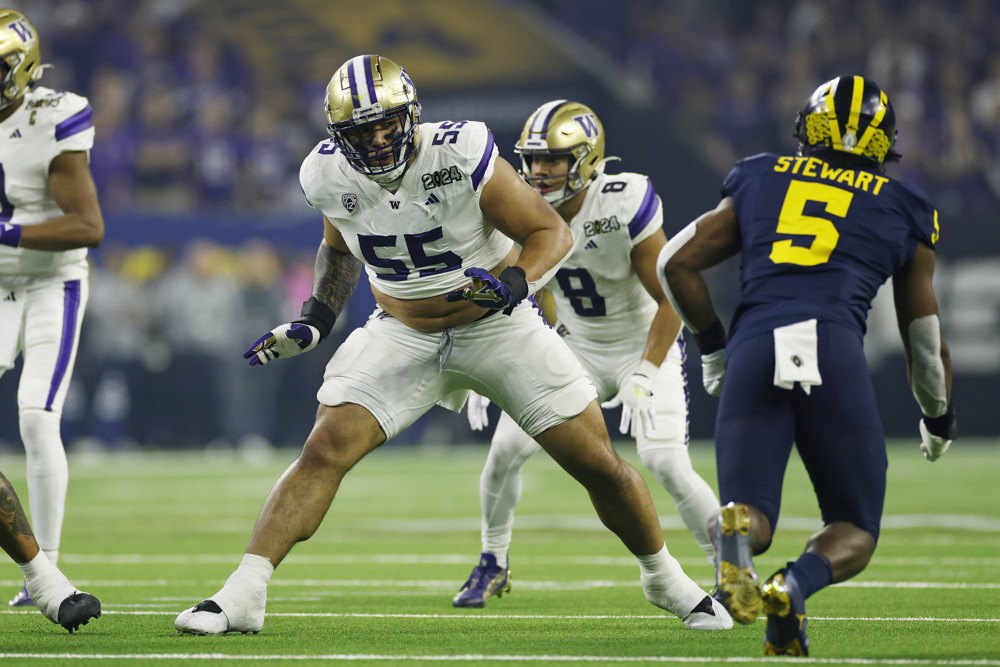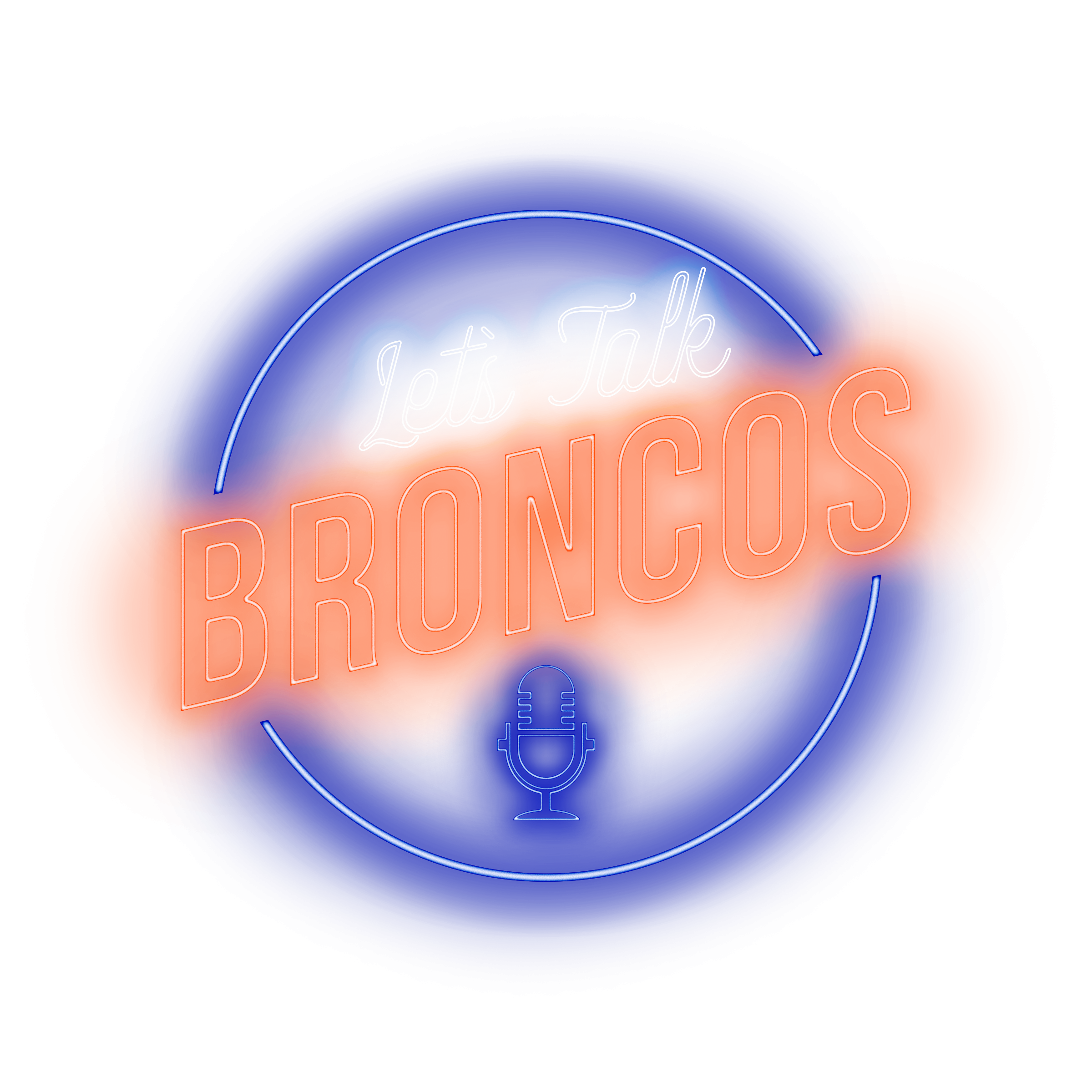
Now with the NFL combine in the rearview mirror, the focus is on the NFL draft as teams allocate a ton of time and effort into studying who could be future difference-makers for their team. The Denver Broncos are charged with that same quest, but their path to finding these difference-makers will be more difficult than others.
Through many trades, the Broncos lack the necessary amount of premium picks — only having two selections in the top 100 — that it would usually take to kick off a rebuild.
That said, this is exactly what George Paton and Sean Payton signed up for, so it’s hard to summon too much pity for them.
To negate the damage their lack of darts could cause, it is an absolute must that Denver hits big on their first-round pick while still finding some ‘diamonds in the rough’ throughout the rest of the draft.
R.1 P.12 Troy Fautanu, OT, Washington
Shorter than your average offensive tackle, at around 6-foot-3, Fautanu answered the question everybody was asking — ‘are his arms long enough?’
It looked like the biggest concern for people was Troy Fautanu’s arm length, but his measurements seemed to silence the noise of him being “guard only” in the NFL. Per @ConnorJRogers
— Brandon Loree (@Brandoniswrite) March 4, 2024
“Washington offensive lineman Troy Fautanu’s arm length coming in at 34 ½” gives him a legit… https://t.co/kmJ2oj6JDD
Fautanu’s 34-inch battering rams clear the NFL’s standard for the tackle position, with some room to spare even.
That no longer looming over his draft evaluation, scouts can just focus on his game, and he is a pretty spectacular player.
Obligated to post filthy Troy Fautanu reps pic.twitter.com/HRkbcLKFC9
— Ben Glassmire (@BenGlassmireNFL) January 7, 2024
Many talk about a pass rusher’s “bag” to describe all the different techniques they have to ultimately make their way to the quarterback. In an attempt to make the offensive line sound more cool, I will do the same in describing Fautanu’s way of blocking.
With an array of different pass sets and hand techniques, Fauntanu probably has more in his “bag” than any other offensive lineman in this class. He is very refined in pass protection, making him a trustworthy blocker from the moment he steps into the league.
To go along with this, Fauntanu moves like a gazelle in open field and also displays an absurd amount of aggression, constantly looking to displace opposing defenders.
Holy mother of savage blocks Troy Fautanu 👀 pic.twitter.com/ddt1pTNmZe
— BOLTS Draft Talk (@BoltsDraftTalk) February 8, 2024
While the aggression is fantastic, It may also be his biggest downfall.
Knockout blows are amazing to see from your offensive lineman, often making highlight-worthy plays, but it is also important to play in control, which is an area Fautanu has struggled in.
Nonetheless, getting the offensive line a high end talent with the potential to play any of the five positions along the line at an elite level would be a no-brainer — especially considering the skyrocketing offensive guard market.
R.3 P.76 Michael Hall Jr, DL, Ohio St
Michael Hall could very well go before the Broncos third-round selection, but in this scenario, Paton lands the Broncos a substantial upgrade for their pass rush.
Hall is a bit of a tweener — only weighing around 280 pounds — but what he lacks in size, he makes up in twitch and movement. Often getting to the quarterback with a signature arm over move, Hall has a game reminiscent of former Broncos interior defensive lineman Dre’Mont Jones.
Ohio State DT Michael Hall Jr. has so much potential. Shows great bend and hand usage as a rusher. With the guys ahead of him gone, he can be a big piece to the Buckeye's defense improving in 2023 pic.twitter.com/r4Mo5oPg2E
— Joe DeLeone (@joedeleone) June 27, 2023
Like Jones, his athleticism lends himself to being more versatile up front, being a piece for a creative defensive coordinator to place anywhere on the defensive front to add extra pass rush, which we know Vance Joseph values.
The most shocking part of Hall’s game comes against the run, where Hall’s deficiencies in size are noticeable, but also made up for through his sheer want and will. Hall always plays like his hair is on fire, never backing down from the competition.
With that being said, NFL offensive linemen are bigger, stronger, and faster than Hall faced in college, making his small frame a major red flag at the next level.
At this stage in the draft though, the value is too good to ignore.
R.4 P.120 Jermaine Burton, WR, Alabama
With the Broncos trading Jerry Jeudy, they’ll look to replace him here with different Crimson Tide wide receiver — Jermaine Burton.
While they both played for the same school, Burton is very different than Jeudy. He primarily wins downfield, and displays great acceleration to get on the opposing defensive back’s toes in a hurry. Once downfield, Burton does a great job adjusting to the ball, ultimately winning the rep more than your average receiver would. That’s only made more impressive when considering the scattershot accuracy Burton was dealing with from the quarterback position.
They tried to lie on my guy Jermaine Burton this morning I had to go double check 😂 pic.twitter.com/2hK8LeZYfL
— J Tuck (@jtuck151) March 5, 2024
While Burton’s ability to separate downfield is his calling card, he is not a one-trick pony. He’s not the most fluid athlete in and out of his breaks, but Burton is better route-runner than one would anticipate — making him a receiver capable of winning all over the field.
Jermaine Burton film is cool because you see an NFL route tree. pic.twitter.com/kSYliGkEgd
— (Foots The King) (@FootsDaKing) March 6, 2024
At this point, Burton’s biggest concern comes through his play strength, as he’s pretty slender for your typical NFL outside wide receiver.
On film, Burton flashes the potential to work against press coverage but it is not always consistent. To go along with this, Burton must work on fighting through contact while running his route as he often finds himself getting pushed off his stem.
He would still serve as an immediate upgrade for Denver’s group of pass-catchers though, and that’s not the easiest thing to find at this point in the draft.
R.5 P.135 Luke McCaffrey, WR, Rice
In this scenario, the Broncos take back-to-back wide receivers, selecting Valor Christian’s own Luke McCaffrey.
McCaffrey started his college career playing quarterback for the University of Nebraska but since then has reinvented himself as a wide receiver at Rice University. Because of the position change, McCaffrey is very much still learning his new position but the film he’s put out shows a lot of promise.
Primarily aligning from the slot, McCaffrey is a big receiver for the position, standing around 6-foot-2, and it shows in his play.
Not sure how we've gotten to pro-day season and there's still such little buzz on younger brother of reigning NFC Offensive POY.
— Jim Nagy (@JimNagy_SB) March 9, 2024
Usually siblings get over-hyped but Rice's Luke McCaffrey continues to fly under radars, even after strong @seniorbowl week and Combine.… pic.twitter.com/3kwc9p5Ruf
Both through his time at Rice and in his attendance at the Senior Bowl, McCaffrey has shown that he is more than willing to work the middle of the field, displaying the toughness needed to catch the ball through contact and complete the play. His size can also aid him in blocking, something becoming more and more valuable for slot players.
This toughness also lends itself downfield, where McCaffrey will often win in 50-50 ball situations, making the big play.
If we're just looking for a converted QB with elite ball skills player comp for Luke McCaffrey, it's Raiders' ultra-dependable vet Jakobi Meyers.
— Jim Nagy (@JimNagy_SB) March 9, 2024
We thought Meyers had best contested ball skills in 2019 WR class and he still somehow shockingly went undrafted.
Meyers is a guy… pic.twitter.com/rMQavVt6rG
R.5 P.144 Ray Davis, RB, Kentucky
In this scenario, the Broncos continue to load up on the offensive side of the ball, going with Kentucky running back Ray Davis.
Davis is not the most explosive of backs but gives the Broncos another consistent, three-down, type of runner while the team attempts to figure out if Javonte Williams can return to pre-injury form.
Ray Davis with a crazy run here. Leaps bodies and lands with a simultaneous cut outside for big gain. Has 3 down back upside. pic.twitter.com/fRMM8ggO0B
— Marcus Johnson (@TheMarcJohnNFL) March 6, 2024
Most importantly, Davis brings something different to the Broncos’ running back room, being a fantastic processor behind the line of scrimmage. Gaining yards without having to break multiple tackles first, in this regard, Davis runs very much like a league veteran.
With this move, the Broncos running back room will have four running backs capable of making a final roster. While it is unlikely that all four do, it is the price to pay for the uncertainty around Williams.
R.5 P.146 Johnny Dixon, CB, Penn State
Finally drafting another defender, the Broncos select cornerback Johnny Dixon out of the University of Penn State to help fortify their secondary.
Dixon isn’t the biggest at 5-foot-11 but you would never know watching his film, as he is as competitive as it comes.
PSU CB Johnny Dixon listed at 6'0 196
— EJHolt_NFLDraft🏈 (@EJunkie215) March 5, 2024
Injury kept him out of the Combine, but the film shows a physical twitched up athlete thats sticky in coverage. I can see him having a role as a slot defender at the next level pic.twitter.com/8CK779HsZ9
Best utilized in press man, Dixon uses every bit of his length and competitive fire to make it tough on opposing receivers while attempting to get into their route. He does this while utilizing great footwork and technique.
The biggest area of concern in Dixon’s evaluation comes from the intangibles. He is not the biggest, fastest, or strongest, pushing him down to the fifth round. For Dixon to succeed in the NFL he must first find a role on special teams while developing his skills at corner.
R.6 P.202 Mark Perry, S, TCU
Knowing Colorado well, as a former Buff, Perry would be a great developmental safety option for the Broncos.
After transferring to TCU, Perry’s production exploded, as he helped the Horned Frogs in their effort at a National Title run.
Perry is a big and versatile safety, standing 6-feet tall and weighing 215 pounds, and he pairs that size with excellent athleticism. While he was not able to showcase his talents at the NFL Combine, watch for a big-time performance from Perry at the Horned Frogs’ upcoming pro day.
This size and athleticism combination should bode well on special teams, where most sixth-round selections have to make a name for themselves first.
R.6 P.206 Marist Liufau, LB/EDGE, Notre Dame
While giving Vance Joseph another versatile, linebacker/edge hybrid, sounds insane, Paton and the Broncos have already spoken to Liufau at the Combine.
At the University of Notre Dame Liufau was deployed in multiple different alignments in an effort to allow his athleticism to shine. Predictably, his versatile style of play may leave him without a position all together but nonetheless, Liufau is a terrific athlete who plays physically and loves to hit.
Notre Dame LB Marist Liufau –
— Cønnør (@BernienChompz) March 6, 2024
RAS: TBD
– Can play off ball and as an edge rusher
– Ideal size
– Explosive
– More than willing to lay a big hit
– Sheds blocks exceptionally well
– Needs to wrap up better
– Also needs to develop another move or two
pic.twitter.com/C0L7fSrqRa
Much like the prospects before him, Liufau must carve out a role on special teams to ultimately make an NFL roster.
